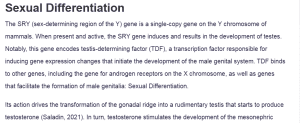Sexual Differentiation
The SRY (sex-determining region of the Y) gene is a single-copy gene on the Y chromosome of mammals. When present and active, the SRY gene induces and results in the development of testes. Notably, this gene encodes testis-determining factor (TDF), a transcription factor responsible for inducing gene expression changes that initiate the development of the male genital system. TDF binds to other genes, including the gene for androgen receptors on the X chromosome, as well as genes that facilitate the formation of male genitalia: Sexual Differentiation.
Its action drives the transformation of the gonadal ridge into a rudimentary testis that starts to produce testosterone (Saladin, 2021). In turn, testosterone stimulates the development of the mesonephric duct into the male reproductive system. In addition, the testes secrete mullerian-inhibiting factor (MIF), a hormone that disintegrates the paramesonephric duct (Saladin, 2021). In the absence of SRY protein, the female genitalia are developed (Heidari et al., 2023).
Sexual differentiation in fetuses begins by the end of the 9th week, and by the end of the 12th week, female or male genitalia are formed (Saladin, 2021). Male and female organs that form from identical embryonic structures are called homologous. In this regard, the penis and clitoris are homologous, and “the scrotum is homologous to the labia majora” (Saladin, 2021, p. 1010).
Sex is the category into which humans and other sexually reproducing species belong with regard to sex chromosomes. Individuals with a Y sex chromosome are male, and those lacking a Y are categorized as female. Conversely, Saladin (2021) states that gender refers to an individual’s understanding of male, female, or sexual identity.
The distinction between these terms is important in separating biological traits from those that are shaped by social or societal aspects. Additionally, this distinction ensures the accuracy of medical research and treatment and that individuals receive appropriate interventions.
References
Heidari, F., Rahbaran, M., Mirzaei, A., Tabatabaei, M. M., Shokrpoor, S., Mahjoubi, F., Ara, M. S., Akbarinejad, V., & Gharagozloo, F. (2023). The study of a hermaphroditic sheep caused by a mutation in the promoter of SRY gene. Veterinary and Animal Science, 21, 100308. https://doi.org/10.1016/j.vas.2023.100308
Saladin, K. (2021). Anatomy and physiology: The unity of form and function (9th ed.). McGraw-Hill Education.
The SRY (sex-determining region of the Y) gene is a single-copy gene on the Y chromosome of mammals. When present and active, the SRY gene induces and results in the development of testes. Notably, this gene encodes testis-determining factor (TDF), a transcription factor responsible for inducing gene expression changes that initiate the development of the male genital system. TDF binds to other genes, including the gene for androgen receptors on the X chromosome, as well as genes that facilitate the formation of male genitalia: Sexual Differentiation.
Initial Post Instructions
- What developmental changes will occur if the SRY gene is present and active? What structures are homologous between those assigned male at birth (AMAB) and those assigned female at birth (AFAB)? Why is it important to have a distinction between the terms “sex” and “gender”?
Sexual Differentiation

